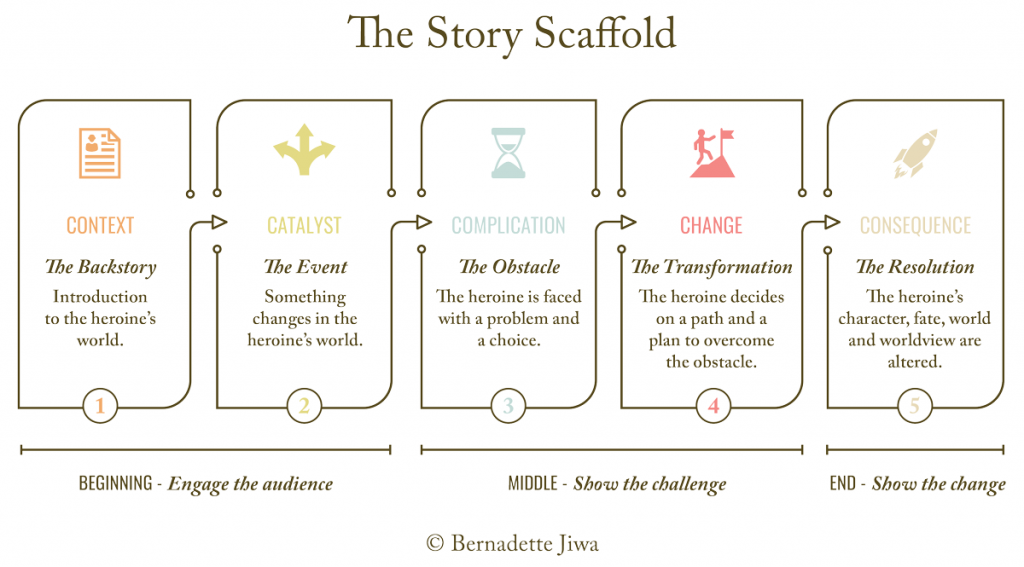Unlock the Magic in Your Story Now
Get the Free 20 questions to Ask Before Launching Your Idea workbook when you sign up for occasional updates.
Get the Free 20 questions to Ask Before Launching Your Idea workbook when you sign up for occasional updates.
Articles filed in: Story Skills
Pitch Perfect
filed in Marketing, Story Skills, Strategy

The two falafel makers at the weekend market sell an almost identical product but achieve very different levels of success. The marketing tactics they use are similar. Make eye contact with potential customers, offer them a small sample to try and use the time they’re chewing to launch into your sales pitch.
The first maker tells passers-by his falafel are the best in the world. ‘I should know, I make them,’ he proclaims.
The second tells potential customers that her falafel are vegan, dairy and gluten free. ‘They are delicious hot or cold. Wrap them in pitta bread with some salad and hummus, and you’ve got an easy, tasty and healthy lunch,’ she says, as customers line up to hand her their ten dollar notes.
We spend days, months and sometimes years perfecting our product recipe. We should honour that devotion to creating something that matters by perfecting our sales script too. If you want to make something matter, you must be able to tell the people you want to serve why it should matter to them.
Image by Stijn Nieuwendijk
Why Do Customers Choose You?
filed in Marketing, News, Story Skills, Storytelling, Strategy

What are the top three reasons customers choose you? What story are you giving those customers to tell—not just to recommend you, but to trust and value, prefer and remain loyal to you or your company?
You can make assumptions and best guesses about what’s motivating the people you serve, or you can ask for reasons they will happily share. The stories your customers tell themselves are part of the story you need to tell.
Image by Garry Knight
How To Tell A Story Using The Story Scaffold
filed in Marketing, Story Skills, Storytelling

There’s no question that stories are the best way to engage and persuade people. We have good scientific evidence to prove it. According to neuroeconomist, Professor Paul Zak, ‘Narratives that cause us to pay attention and also involve us emotionally are the stories that move us to action.’ It’s our very makeup, our physiology, that enables us to empathise and to be persuaded by stories. This physiological connection between head and heart is the reason stories work.
Zak goes on to say, ‘Stories that are personal and emotionally compelling engage more of the brain, and thus are better remembered than simply stating a set of facts.’ All compelling stories follow a simple three-act structure, with a beginning, where the scene is set. A middle where something happens. And an ending where we find out what happens as a result of what happened. The sequence of events—what we reveal to the audience, when, is what makes stories work. The goal is to keep the audience wondering what’s going to happen next all the way to the end. When you can’t put a book down, it’s because the author nailed the story structure. The author’s goal is to keep you turning the pages.
Philosophers and scholars like Aristotle, Freytag and Campbell, analysed dramatic structure and gave us story formulas like the hero’s journey to help us become better storytellers. Every successful movie follows these formulas. But they are overly complex for stories we tell every day.
At its simplest, the sequence of events in a story happens in five stages.

The 5C’s of The Story Scaffold
1. CONTEXT
The Backstory
Introduction to the hero’s or heroine’s world.
2. CATALYST
The Event
Something changes in the hero’s or heroine’s world.
3. COMPLICATION
The Obstacle
The hero or heroine is faced with a problem and a choice.
4. CHANGE
The Transformation
The hero or heroine decides on a path and a plan to overcome the obstacle.
5. CONSEQUENCE
The Resolution
The hero’s or heroine’s character, fate, world and worldview are altered.
You can test this structure by mapping it onto any memorable story from Cinderella to Toy Story. Think about what happens in Toy Story when Woody, Andy’s favourite toy is confronted with the arrival of Buzz Lightyear and how he changes throughout the story as a result.
You can use The Story Scaffold to become a better storyteller, not only when you’re marketing but in everyday conversations. Sometimes you will be the hero of the story. But more often when you write persuasive sales and marketing copy, pitch a winning presentation or create great customer experiences, it’s the customer’s or client’s story you’re telling.
Storytelling isn’t just the best way to be seen and heard in a meeting or on a stage. It’s how we engage with people every day by showing that we see them.
If you’d like to practice using The Story Scaffold to tell better stories, consider The Story Skills Workshop.
Image by Carmelody
Signalling
filed in Marketing, Story Skills, Storytelling

According to the Collins English Dictionary, a signal ‘is a gesture, sound, or action which is intended to give a particular message to the person who sees or hears it.’
We are sending signals to our clients and customers whenever they come into contact with our business or brand—even when we’re not face-to-face. Words, images, dress, titles, tone, body language, location, prices, packaging, decor and design give people clues about who we are, what we stand for and what we’re worth. The flipside is that when we allocate resources, we’re also sending a signal to ourselves about what we’re worthy of.
Customers are making decisions based on our signals, so it pays to be intentional about every signal we send. When I get an email, like the one I got yesterday from an insurance company assuring me that my query is important to them ‘and will be replied to within three business days,’ I’m forming an opinion about what it would be like to be a paying customer with an urgent request.
Of course, in the days of online customer reviews, we can’t always control the message—which is all the more reason to make sure that the story we tell when we can is sending the signal we intended to send.
Image by Garry Knight
What The Best Communicators Do
filed in Marketing, Story Skills, Storytelling

Professor Daniel Kahneman has spent a lifetime researching why and how humans make decisions. His decades of work focused on the two ways we think and decide using one of two modes of thought, System 1 and System 2. System 1 makes fast, instinctive and emotional judgements and System 2 operates at a slower more logical level. Kahneman wrote a five hundred page book on the subject titled Thinking Fast and Slow.
Of course, just like us, even Nobel prizewinning researchers don’t usually have a lifetime or five hundred pages to explain the impact of their work. We often only have someone’s attention for seconds, let alone minutes. The mistake we make as communicators, marketers and salespeople is believing that we need to give people all the information while we have their attention—that’s what we were taught at school. We were not penalised for writing down everything we knew in an exam. The best way to win at exams was to write down everything we knew. But this doesn’t work when we’re face-to-face with people.
The goal isn’t just to deliver the information—it’s to capture the imagination. This is how we communicated as children—in stories, not facts. But over the years we’ve unlearned all of that. If we’re serious about making an impact, we need to start reclaiming those innate storytelling skills we once had.
When Professor Kahneman describes how System 1 works, he tells the story about calling his wife Anne on the phone and knowing immediately what kind of mood she’s in just by hearing her tone of voice when she picks up. Whenever he tells that story, the audience laughs, they nod their heads, they immediately get it.
The next time you’re asked a question about what you do or why it works, don’t go into a long explanation. Just start with the words, ‘let me tell you a story’.
Image by Garry Knight
- « Previous
- 1
- …
- 4
- 5
- 6